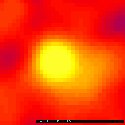RXTE Discoveries
RXTE Spots Gamma Ray Bursts - September 1997
 Optical counterpart of a GRB, as shown by HST |
In August of 1997, RXTE's All-Sky Monitor (ASM) detected two Gamma Ray Bursts (GRB), named GRB970815 and GRB970828. The burst rise of GRB970815 was detected in one of ASM's camera and then a second, after a six degree rotation of the ASM assembly. These two observations, made at different orientations, enabled an estimate of the source's position within 12 hours of detection. The burst lasted 130 seconds, with an intensity that peaked twice, the second time its maximum intensity neared 2 Crab in the 2-12 keV band.
|
The second GRB, GRB970828 was also observed by two of the ASM's cameras for its 160 second duration. One camera showed a mean flux of 756 milliCrab; 90 seconds later the second camera recorded a flux of only 238 milliCrab. Its intensity was shown to have an exponential decay with a 30 second time constant. The two cameras were able to plot its position to be at an R.A. of 18h8m29s and Dec. of +59°18'.0 (equinox 2000). One of RXTE's other instruments, the Proportional Counter Array (PCA) reported the detection of an X-ray source whose coordinates were consistent with those of the GRB. A scant 3.5 hours after the ASM's initial detection of the burst, PCA began a 40 minute observation of this region, finding a source of intensity in the 2-10 keV band of about 0.5 milliCrab. We know of no catalogued X-ray source at these coordinates, so it may be that PCA detected an X-ray afterglow of this burst.


